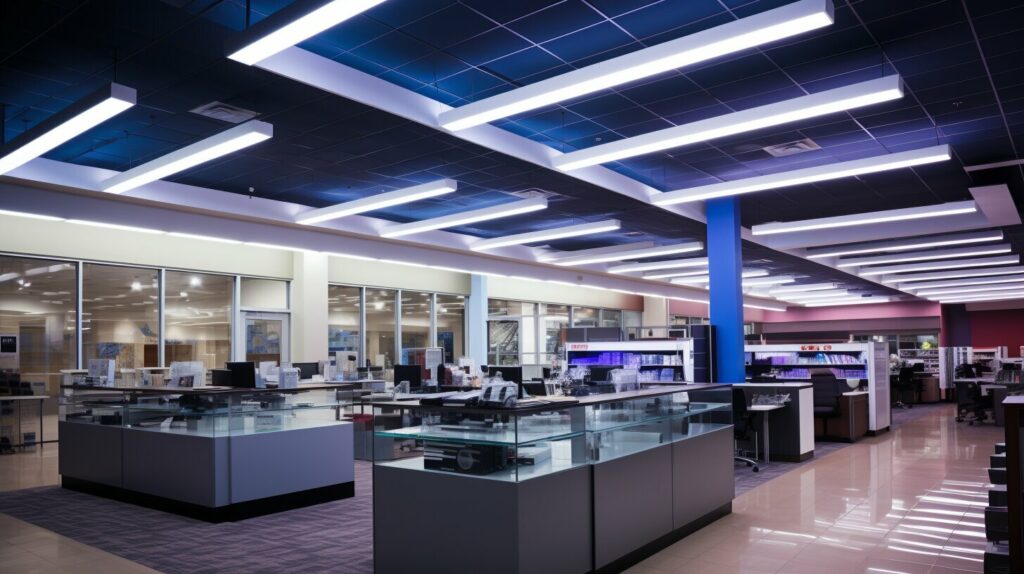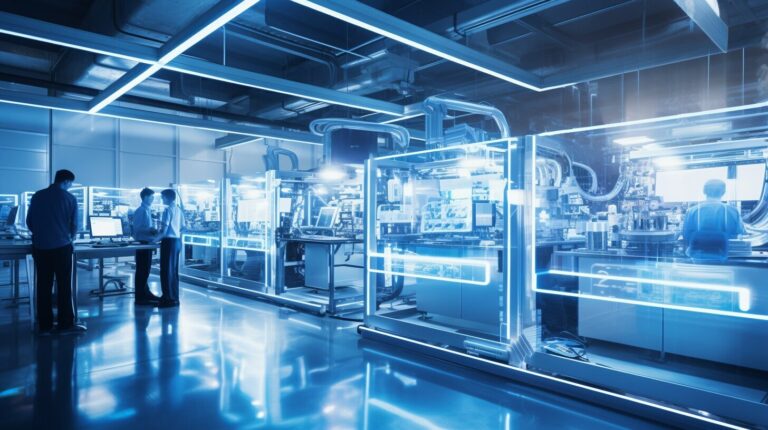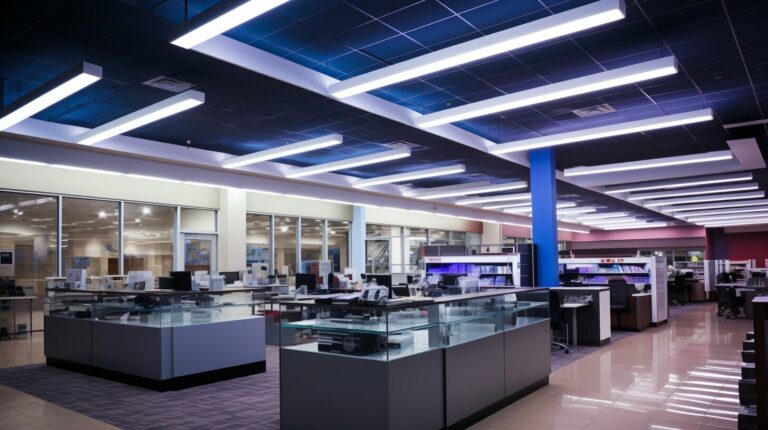Are you familiar with the latest commercial LED lighting trends for 2023? If not, it’s time to pay attention. LED lighting solutions are becoming increasingly important in the market, and businesses need to stay informed to remain competitive.
As sustainability and energy efficiency continue to be a significant focus, more and more businesses are embracing LED lighting solutions. Not only do they save money in the long run, but they also contribute to environmental goals and improve employee productivity and well-being.
Energy-Efficient Lighting: Embracing Sustainability in Lighting
Are you looking to reduce your business’s carbon footprint and contribute to sustainability goals? One way to do so is by adopting energy-efficient lighting solutions. LED lighting, in particular, offers numerous benefits for businesses seeking to embrace sustainability in lighting.
LED lights have a longer lifespan than traditional lighting solutions, meaning less waste and lower maintenance costs in the long run. Additionally, they consume less energy, resulting in reduced electricity bills and lower carbon emissions. By implementing LED lighting solutions in your business, you can take a significant step in reducing your environmental impact and promoting a sustainable future for all.
But the benefits of energy efficiency go beyond environmental concerns. They can also positively impact your bottom line. By reducing energy consumption, you can save on electricity bills and reinvest those savings into other areas of your business. Furthermore, LED lighting can improve employee productivity and well-being, creating a more comfortable and conducive work environment.
The Benefits of Commercial Lighting Upgrades
If you’re a business owner, you know that keeping your operating costs low is crucial. One area where you can save money is with your lighting system. Upgrading to LED lighting solutions can result in significant cost savings and several other benefits for your business.
| Benefits of Commercial Lighting Upgrades |
|---|
| Improved Energy Efficiency |
| Lower Maintenance Costs |
| Enhanced Lighting Quality |
LED lighting is more energy-efficient than traditional lighting solutions, such as incandescent or fluorescent bulbs. This means you will save money on your energy bills and reduce your carbon footprint. Additionally, LED bulbs have a longer lifespan than traditional bulbs, which means you’ll spend less money on maintenance and replacements.
Another benefit of LED lighting is the enhanced lighting quality it provides. LED bulbs produce a bright, clear light that eliminates flickering and provides consistent lighting. This can improve the safety and productivity of your business by reducing eye strain and creating a more comfortable environment for employees and customers alike.
Overall, upgrading to LED lighting solutions is a wise investment for any business. It can provide cost savings, enhance lighting quality, and contribute to your sustainability goals. Contact a professional to discuss how you can implement commercial lighting upgrades in your business today.
Smart Lighting Technology: Revolutionizing Commercial Spaces
LED lighting solutions are transforming the way businesses operate by integrating innovative technologies that enhance efficiency, productivity, and comfort.
Intelligent Automation
Through the use of sensors and advanced controls, smart lighting technology can optimize energy consumption by automatically adjusting brightness based on occupant activity and natural light levels. This reduces waste and improves lighting efficiency, resulting in significant cost savings for businesses.
Enhanced Occupant Comfort
Smart lighting systems provide customizable lighting options that allow occupants to adjust lighting levels and color temperature to suit their individual needs. This can help reduce eye strain, improve mood, and enhance overall well-being, resulting in increased productivity and satisfaction in the workplace.
Productivity Boosts
Smart lighting technology can also be used to create lighting environments that stimulate focus, creativity and relaxation. For example, dynamic lighting systems can adjust lighting levels throughout the day to mimic natural sunlight, helping regulate the body’s natural circadian rhythms and promoting a healthier work environment.
By embracing smart lighting technology, businesses can effectively optimize lighting efficiency and contribute to a more sustainable future. Contact an experienced professional to learn more about how to implement these solutions in your commercial space.
Cost-Saving Lighting Solutions for Businesses
If you’re looking to save money in your business, consider turning to LED lighting solutions. LED bulbs use up to 75% less energy than traditional incandescent bulbs, which means significant savings on your energy bill. Plus, LED bulbs have a longer lifespan, lasting up to 25 times longer than incandescent bulbs, which means you’ll spend less on replacements and maintenance.
LED lighting solutions also offer potential government incentives, such as tax credits and rebates for making the switch from traditional lighting. These incentives can help offset the initial costs of upgrading to LED lighting and further reduce your expenses.
Boosting Productivity with LED Lighting
Did you know that the quality of lighting in your workspace can have a significant impact on your productivity and well-being? With LED lighting solutions, you can create an optimal work environment that promotes comfort and efficiency.
LED lighting mimics natural daylight, which has been shown to improve mood, energy levels, and concentration. By contrast, traditional fluorescent lighting can cause headaches, eye strain, and fatigue, leading to decreased productivity and increased absenteeism.
LED lighting can also be customized to suit your specific needs. Dimmable fixtures allow for greater control over lighting levels, creating a more comfortable and personalized workspace. Additionally, LED lighting can be used to highlight key areas and enhance the overall ambiance of your business.
By upgrading to LED lighting, you can create a more pleasant work environment that promotes productivity and well-being. Your employees will thank you.
Environmental Benefits of LED Lighting
LED lighting not only benefits businesses financially, but also helps to protect our environment by reducing carbon emissions. By making the switch to LED lighting, your business can significantly lower its energy consumption and carbon footprint.
Traditional lighting solutions like incandescent and fluorescent bulbs require more energy to produce the same amount of light as LED bulbs. This increased energy consumption leads to higher carbon emissions and contributes to climate change. LED lighting, on the other hand, uses up to 80% less energy and can last up to 25 times longer than traditional lighting solutions.
Additionally, LED lighting reduces light pollution, which can have negative effects on wildlife and ecosystems. The focused directional lighting of LED bulbs helps to reduce wasted light and minimize light pollution in outdoor spaces.
By adopting LED lighting solutions, businesses can contribute to their sustainability goals and make a positive impact on the environment. Start your journey towards sustainability by upgrading your lighting system to energy-efficient LED bulbs.
Optimizing Lighting Controls for Enhanced Efficiency
Installing LED lighting solutions is a great step towards optimizing energy efficiency, but businesses can take further action by implementing advanced lighting controls. These controls provide a range of benefits, such as enabling automated adjustments to lighting levels, occupancy sensing, and daylight harvesting.
Dimming is a particularly useful lighting control, allowing businesses to lower light levels when natural daylight is present. This reduces energy consumption while still ensuring a comfortable level of visibility for occupants. Occupancy sensors can also help to minimize unnecessary lighting use by monitoring whether a space is occupied and adjusting the lighting accordingly.
In addition, the use of daylight harvesting systems can optimize natural light usage, reducing the need for artificial lighting and providing significant cost savings. By automatically adjusting the lighting according to available daylight, businesses can reduce energy costs and minimize environmental impact.
The Role of Lighting Design in Commercial Spaces
Lighting design plays a crucial role in creating a welcoming and efficient commercial space. Whether you run a retail store, an office, or a restaurant, the right lighting can enhance your customers’ experiences, improve productivity, and reduce energy consumption.
One of the benefits of LED lighting is its flexibility in design. With LED lights, you have the option to choose from a wide range of temperature and brightness levels, which can affect the mood and ambiance of your space. Whether you want to create a warm and cozy atmosphere or a bright and energizing one, LED lighting can help you achieve your desired effect.
Another important aspect of lighting design is emphasizing key areas of your commercial space. For example, you may want to highlight your merchandise displays, your office reception desk, or your restaurant’s kitchen area. By strategically placing LED lights, you can draw your customers’ attention to the most important parts of your space and enhance their experience.
Lastly, LED lighting can help you improve the overall aesthetic appeal of your commercial space. With the right lighting design, you can create a welcoming and attractive environment that reflects your brand’s values and attracts more customers.
Emerging Trends in Commercial LED Lighting
As 2023 approaches, the commercial LED lighting industry is set to undergo significant transformations. To remain competitive and meet the evolving demands of customers, it is essential to stay informed about the emerging trends in this field.
Integration of IoT and Smart Lighting
The Internet of Things (IoT) and smart lighting are two major trends shaping the future of commercial LED lighting. By integrating these technologies, businesses can optimize energy efficiency, improve occupant comfort, and enhance productivity. Smart lighting systems allow businesses to customize lighting based on occupancy, daylight, and other factors, using sensors and controls to create automated and energy-efficient lighting environments.
Human-Centric Lighting Design
Human-centric lighting design is another emerging trend that businesses should take note of. This involves creating lighting systems that align with our natural circadian rhythms, enhancing well-being, productivity, and even sleep quality. By providing dynamic lighting that changes throughout the day, businesses can create a more comfortable and light-synchronized environment for their employees.
Wireless Connectivity and Li-Fi
Wireless connectivity and Li-Fi technology are also revolutionizing commercial LED lighting. Li-Fi allows businesses to transmit data using LEDs, providing a secure and high-speed wireless connection. This technology eliminates the need for traditional Wi-Fi and improves security, making it an attractive option for businesses that require reliable and efficient data transmission.
With these trends on the horizon, businesses that adopt LED lighting solutions and stay abreast of industry advancements will be poised for success in the years to come.
Implementing LED Lighting Solutions in Your Business
Now that you are aware of the benefits of LED lighting solutions, it’s time to start thinking about how to implement them in your commercial space. Here are some practical steps you can take:
- Conduct an energy audit to determine lighting requirements and areas for improvement.
- Work with experienced professionals to design a lighting system that meets your specific needs.
- Consider a phased approach to implementation, starting with high-priority areas and gradually expanding to the rest of the space.
- Educate employees on how to use and maintain the new lighting system for optimal efficiency and performance.
- Regularly review and adjust the system as needed to ensure continued energy savings and overall effectiveness.
By following these steps, you can successfully transition to LED lighting and start reaping the many benefits it offers. Don’t hesitate to reach out to experts in the field for guidance and support along the way.
Conclusion
Commercial LED lighting trends for 2023 will have a major impact on your business. By embracing energy-efficient lighting solutions, you can contribute to sustainability goals while saving on costs. Upgrading to LED lighting can provide significant improvements in energy efficiency, cost savings, and lighting quality. Smart lighting technology can transform your commercial spaces by optimizing efficiency and increasing productivity. LED lighting also offers significant environmental benefits, including reduced carbon emissions and lower light pollution.
The key to success is in optimizing lighting controls, effective lighting design, and staying informed of the latest trends in the market. By implementing LED lighting solutions in your business, you can create a comfortable and conducive work environment, contribute to sustainability goals, and gain a competitive edge in the market.
Stay Ahead of the Game with LED Lighting Solutions
Don’t wait until 2023 to start exploring commercial LED lighting solutions. Conduct an energy audit, identify lighting requirements, and work with experienced professionals for a successful transition. With the right approach, you can optimize your lighting systems and create a more efficient, productive, and sustainable business environment. Stay ahead of the game with LED lighting solutions.




